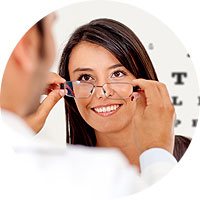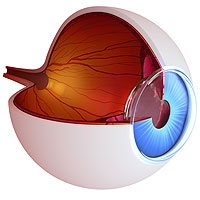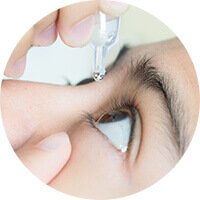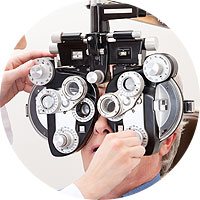Medical Eyelid Procedures
 Eye Care Specialists’ surgeon’s specialties encompass surgery of the eyelids; tear drainage system and the orbit. In addition to managing complex medical and surgical cases, they also provide a broad array of facial rejuvenation services, including cosmetic eyelid surgery, small-incision endoscopic brow lifts, skin rejuvenation, and anti-aging laser treatments, as well as Botox and collagen fillers for wrinkle reduction.
Eye Care Specialists’ surgeon’s specialties encompass surgery of the eyelids; tear drainage system and the orbit. In addition to managing complex medical and surgical cases, they also provide a broad array of facial rejuvenation services, including cosmetic eyelid surgery, small-incision endoscopic brow lifts, skin rejuvenation, and anti-aging laser treatments, as well as Botox and collagen fillers for wrinkle reduction.
Ophthalmic Plastic and Reconstructive Surgery is a specialized area of ophthalmology that deals with the management of eyelid disorders including the lacrimal (tear) system, the orbit (the bone cavity surrounding the eye), and the adjacent face.
Hear from Dr. Roth, our Oculofacial Specialist
With age, sun exposure, sleep apnea disorder causing floppy eyelid syndrome, or genetic factors; loose skin and excess fat may accumulate in your upper and lower eyelids. Blepharoplasty corrects sagging eyelids, excess folds and under-eye pouches. The surgery is performed under local anesthesia with sedation and takes one to two hours. You can resume light activity within three days, and exercise and more vigorous activities in one week.
In upper eyelid surgery, an incision is made externally in the upper eyelid crease to remove excess eyelid skin and fat. The original incision is then closed with fine, dissolvable sutures. Because the incisions are made in the eyelids’ natural contours, they are barely visible and fade with time. There is a mild amount of bruising and swelling following surgery, but this is usually gone within seven days. Patients can typically resume work within three days after the procedure.
In lower eyelid surgery, the incision can be made internally (trans-conjunctival) or externally through the skin. The decision regarding which approach is best for you will be determined by the amount of skin that is present in the lower eyelid. The internal approach leaves no external incision line while the external incision is placed just below the eyelid margin to disguise its appearance. Recovery times are similar to upper eyelid surgery.
Ptosis is the medical term for drooping of the upper eyelids, a condition that may affect one or both eyes. When the edge of the upper eyelid falls, it may block the upper field of your vision. Symptoms of ptosis include a decreased ability to keep your eyes open, eye strain – especially when reading, and eyebrow fatigue from the increased effort needed to raise your eyelids. Acquired ptosis is treated surgically, with the specific operation based on the severity of the ptosis and the strength of the levator muscle. Surgery is designed to reattach the stretched muscle to its normal location.
Sometimes brow ptosis is present along with eyelid ptosis or loose skin and excess fat, making the asymmetry more obvious and requiring full assessment and treatment by an oculoplastic surgeon. Brow ptosis is usually a result of the aging changes that affect the forehead muscles and soft tissue, but may also occur as a result of other conditions such as facial palsy or trauma.
The outer layer of skin is called the epidermis. Epidermal cells include flat squamous cells, round basal cells, and pigment-producing melanocytes. The dermis is the deeper layer of skin and contains the hair follicles, oil and sweat glands, and blood vessels. Skin cancers can arise from any of these skin cells. A biopsy is usually required to confirm the diagnosis of skin cancer.
Mohs surgery is a precise surgical technique used to treat skin cancer. During Mohs surgery, thin layers of cancer-containing skin are progressively removed and examined until only cancer-free tissue remains resulting in loss of skin of the eyelid(s). Eye Care Specialists oculoplastic surgeons perform combined procedures with MOHS surgeons to reconstruct the eyelid skin lost during the removal of skin cancer.
Ectropion is the medical term used to describe an abnormal lower eyelid that turns outward and no longer touches the eye. As a result, the conjunctiva (the mucous membrane that lines the eyelid) may become red and exposed. This condition usually involves one or both lower eyelids but rarely, may affect the upper eyelid(s). If the ectropion is due to laxity of the eyelid’s supporting structures, it is best treated surgically.
Depending on the cause, surgery can reposition the eyelid back to its normal position against the eye. Entropion is a condition in which an eyelid turns inward, rubbing against the eye, making it red, irritated, and sensitive to light and wind. If it is not treated, the condition can lead to excessive tearing, crusting of the eyelid, mucous discharge, and irritation of the eye. A serious inflammation could result in damage to the eye.
There are a number of surgical techniques for successfully treating entropion and each surgeon will have a preferred method. The usual treatment for entropion involves tightening of the eyelid and its attachments to restore the lid to its normal position.
The tear drain consists of two small openings called punctum; one in your upper eyelid and the other in your lower eyelid. Each of these openings leads into a small tube called the canaliculus which, in turn, empties into the lacrimal sac between the inside corner of your eye and your nose.
The lacrimal sac leads into a canal called the nasolacrimal duct that passes through the bony structures surrounding your nose and empties tears into your nasal cavity. The most common symptoms are excessive watering, mucous discharge, eye irritation, and painful swelling in the inner corner of your eyelids. Your surgeon may recommend a number of treatments based on the analysis of your symptoms.
When the nasolacrimal duct, the tube which drains tears into the nose, is blocked, due to factors such as infection or congenital (present from birth), a surgical procedure is usually required. During this procedure, called a DCR (Dacryocystorhinostomy), a hole is created between the tear sac and the inside of the nose.
There are many types of facial fractures. Because the eye sockets are a central location on the face, they are commonly involved in accidents involving the face. The oculoplastic surgeons at Eye Care Specialists perform primary repairs after accidents, as well as secondary repairs in patients who have had accidents many years ago or recently had surgery that did not produce a satisfactory result.
One of the most common thyroid diseases is hyperthyroidism, in which there is an overproduction of thyroid hormones. People with hyperthyroidism may experience some degree of eye difficulty. Eye problems are most commonly caused by abnormal swelling of the soft tissues surrounding the eyes, and enlargement of the muscles that move the eyes and open the eyelids.
As a result, the eyes may protrude forward, there may be a retraction of the upper eyelids which forces the lids apart, there is an inability to fully close the eyelids, and an abnormally large amount of the front of the eyes is exposed. This results in wide prominent eyes, a fixed staring expression, and infrequent blinking of the eyelids.
Orbital decompression is the partial or complete removal of one or more, of the four walls of the orbit (eye socket). This procedure is primarily performed for Graves’ disease (thyroid eye disease) placing the eye back into a normal, or less bulging position.
Blepharospasm is characterized by involuntary spasms of the muscles around the eye, resulting in uncontrolled blinking, narrowing, and even closing of the eyelid. BOTOX® (onabotulinumtoxinA) has been used for 25 years as a treatment option for blepharospasm and its symptoms since FDA approval in 1989. BOTOX® is approved to help relieve the eyelid muscle spasms associated with blepharospasm.
Hemifacial spasm (HFS) is a neurological disorder in which muscles of one side of the face intermittently involuntarily contract, causing uncontrollable contortion of the face. HFS typically begins in the muscle surrounding the eye and can spread to involve other muscles on the same side of the face. Botox® is a temporary treatment of the symptoms of HFS.
It does not treat the cause of HFS. Botox® is a bacterial toxin injected by needle into facial muscles that paralyze the muscles so that they do not move when facial nerve hyperactivity occurs in HFS.
Bell’s Palsy is a form of facial paralysis resulting in the inability to control facial muscles on the affected side. Several conditions are thought to cause facial paralysis including brain tumors, stroke, and Lymes Disease, however, if no specific cause can be identified, the condition is known as Bell’s Palsy. Bell’s Palsy can interrupt the eyelid’s natural blinking ability, leaving the eye exposed to irritation and drying.
This condition affects each individual differently as some cases are mild and symptoms disappear in a couple of weeks, while others may need medications or therapeutic treatments. The prognosis for individuals with Bell’s Palsy is generally very good, with the extent of nerve damage determining the extent of recovery. Eye Care Specialists surgeons can help those suffering from Bell’s Palsy regain the ability to close the affected eye.

















